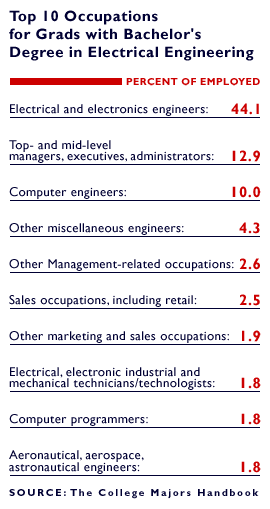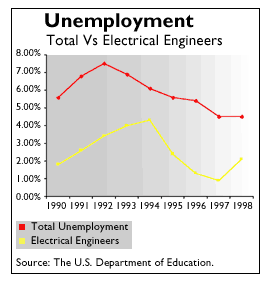|
'Working Your Degree'
|
 |
August 25, 2000: 8:56 a.m. ET
Electrical engineering grads are the belles of the ball as talent pool shrinks
By Staff Writer Shelly K. Schwartz
|
NEW YORK (CNNfn) - It's the kind of degree that can land you a $60,000 job straight out of school. It's been dubbed one of the fastest growing fields in the nation. And it's virtually begging for new recruits.
It's ... It's ... electrical engineering.
Wait! It may sound like the career of choice for your brainiac brother, but those tapped into today's tight labor market say a background in electrical engineering can throw open the doors to some great opportunities. More importantly, they say, it won't necessarily condemn you to a life sentence of spark plug design.
"Twenty or 30 years ago, most electrical engineering grads would go to work for a large electrically oriented company, like Hewlett Packard (HWP: Research, Estimates), GTE, or IBM (IBM: Research, Estimates)," said Sidney Burrus, dean of the EE program at Houston's Rice University. "But, the old days of designing radios seems to be gone."
During a recent visit with a group of Rice EE alumni, in fact, Burrus observed virtually all of them had defected from their field of study to become investment bankers in New York City. Likewise, many of their counterparts in Palo Alto, Calif., are now venture capitalists - and "quite successful ones," he said. And still others are putting their EE degrees to work by becoming patent attorneys, which are in heavy demand by engineering companies looking to protect the technology being developed.
"In today's world, you can think of engineering as more of a liberal arts degree that prepares you for living life," Burrus said. "A lot of people are using it not to become engineers, but to go out and solve problems and do whatever they want to do."
Visit CNNfn's Career page regularly to read "Working your Degree," a new column that highlights job opportunities for a different college major each week. See the links at the bottom of this page for profiles on economics, computer science, physical therapy, history and teaching professions.
What they do
Electrical and electronics engineers design, test, and supervise the development of new technologies.
That, according to the Bureau of Labor Statistics, can include power-generating equipment, controlling and transmission devices used by electric utilities; radar and navigation systems, motors, lighting, and wiring for buildings, automobiles, and aircraft. It's not surprising, however, that the hot new niche for EE grads lies in computer technology, digital devices and communications systems.
"It's not just a job. It's the future," said Tegwin Pulley, vice president of talent, sourcing and diversity for Texas Instruments (TXN: Research, Estimates) in Dallas. "An EE degree can be used for designing products, marketing them and application. We often hire electrical engineers into marketing and sales. There is also a great need now for analog design engineers."
Electrical engineers, the largest of the engineering divisions, held roughly 357,000 jobs in 1998, the most recent year for which data are available. Most of those positions, the BLS reports, were at engineering and business consulting firms, government agencies, and electronic equipment  manufacturers. manufacturers.
Other top employers of EE grads include communications and utilities firms, makers of aircraft and guided missiles, and computer and data processing services firms.
And for the record, California, Texas, New York, and New Jersey —states with the largest number of electronics firms — employ more than one-third of all electrical and electronics engineers, BLS data show.
Looking ahead
Employment for electrical engineers is projected to grow between 21 percent and 35 percent through 2008, the BLS reports. That's faster than the average for all occupations, due largely to the growing demand for computers and other electronic equipment.
"The need for electronics manufacturers to invest heavily in research and development to remain competitive and have a scientific edge will provide openings for graduates who have learned the latest technologies," the Bureau writes in its latest Occupational Outlook report. "Opportunities for electronics engineers in defense-related firms should improve as aircraft and weapons systems are upgraded with improved navigation, control, guidance, and targeting systems."
At the same time, however, the BLS notes "job growth is expected to be fastest in services industries — particularly consulting firms that provide electronic engineering expertise."
The severe shortage of qualified talent is the other leading driver of job growth for EE grads.
At present, the Semiconductor Industry Association estimates roughly 346,000 high-tech jobs nationwide are unfilled. And experts from the National Science Foundation predict a shortfall of 675,000 in all categories of scientists and engineers by 2006.
It's a situation that, for corporate America, has gone from bad to worse, as enrollment in EE programs continues to slide. Data from the Education Department reveal the number of bachelor degrees awarded in electrical engineering plunged 50 percent from 1987 to 1998, dropping to 12,498 in 1998 from 25,000 in 1987.
"This is a huge concern to us, because this field is really where a huge amount of job opportunities are going to come from going forward," Pulley, of TI, said. "Diversity is also a big issue. The percentage of Hispanic, black and female EE students is low. So there's a real untapped talent pool out there of people who could be majoring in electrical engineering and could be looking to a great future with technology companies."
To help reverse the trend, private industry is stepping up. Texas Instruments, for example, gave millions of dollars to some of the top schools in the nation, including Texas A&M, Georgia Tech and the Massachusetts Institute of Technology (MIT) to help them further their EE programs.
"When we looked at the number of engineering students graduating, we knew that it wouldn't even come close to meeting demand," Pulley said.
Hewlett Packard, in Palo Alto, Calif., also works closely with Georgia Institute of Technology in Atlanta.
Mat Hans, a 1998 graduate from Georgia Tech's EE master's degree program, runs the project on campus as its research engineer. He's paid by HP Laboratories, but is busy organizing a group of professors and students to help him research and design "smart appliances." (Basically he's working to develop the next generation of cell phones and other communications devices that will better interact with users and the environment.
"I wanted to be an engineer very early on," said Hans, a French native, who transferred from Supelec University in Paris to Georgia Tech's European annex, also near Paris, to finish his doctorate degree. "I'm the type who likes to solve problems and play around with technical things."
He notes the U.S. job market for electrical engineers is stronger than ever.
"I would definitely suggest to people that they pursue this route," he said. "The job market is really, really hot. The world is turning around in the sense that we used to assume humans had to adapt to machines. But now we're finally saying, 'That's not how it's supposed to work. The machine is supposed to adapt to humans.' A degree in EE is the way to go."
The need for speed
As one might expect, it's important for those pursing an EE degree - and for grads already in the workforce - to keep up with the latest breaking technology.
These days, in fact, many schools have combined their computer and electrical engineering programs into one - called an ECE program.
"Continuing education is important for electrical and electronics engineers, as those who fail to keep up run the risk of becoming obsolete, or at a minimum being more likely to be passed over for promotions," the BLS states in its Occupational Outlook.
Those who do stay plugged in also have stronger earnings potential.
 Median annual earnings of electrical and electronics engineers were $62,660 in 1998, according to Labor Department statistics. The lowest 10 percent earned less than $38,470 and the highest 10 percent earned more than $91,490. Median annual earnings of electrical and electronics engineers were $62,660 in 1998, according to Labor Department statistics. The lowest 10 percent earned less than $38,470 and the highest 10 percent earned more than $91,490.
At the same time, a 1999 salary survey by the National Association of Colleges and Employers reveals that bachelor's degree candidates in electrical and electronics engineering received starting offers averaging about $45,200 a year. Master's degree candidates received offers for more than $57,000; and Ph.D. candidates brought in closer to $71,000.
But that doesn't include any stock options and signing bonuses you might finagle. As an electrical engineer, you can virtually make as much as you can command. Remember, it's an employee's job market for electrical engineers. If you've got a degree -- you've got the inside track. 
-- Click here to send e-mail to Shelly K. Schwartz
|
|
|
|
|
 |

|

